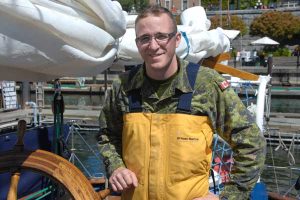Ammo techs get their sea legs
By Lookout on Jun 03, 2013 with Comments 0

Cpl Dominic Pare pauses for a photo at the helm of HMCS Oriole. The ammunition technician from CFAD Angus at CFB Borden was on Oriole for just three days before joining the crew for Swiftsure.
The best way to learn is to do, or so a group of ammunition technicians from Canadian Forces Ammunition Depot (CFAD) Angus, at CFB Borden, learned when they crewed HMCS Oriole for Swiftsure 2013.
The group, here for adventure training, arrived at CFB Esquimalt May 20 and hit the water, many for the first time, the next day.
“I didn’t think I’d ever be working on a sailboat, let alone racing one,” said Cpl Dominic Pare, an ammunition technician. “As an army guy I’m used to working on dry land. Being out on a heaving boat has really changed how I see the navy and the kind of conditions they work in.”
Cpl Pare was prepared for this year’s Swiftsure Yacht Race alongside his fellow ammo techs with just three days of intensive, on-the-water training.
“It was a very challenging experience but very worthwhile,” he says. “When everyone is working together and crewing their individual stations, it feels like a well oiled machine. It’s a rewarding feeling.”
LCdr Jeff Kibble, captain of Oriole, says this year’s crew exceeded expectations.
“I’ve worked them hard but in three days they came together like a real crew,” he said. “We crammed 30 days of training into a three-day period, and the crew fared very well.”
Following their quick trial-by-fire period, the newly minted crew was thrust into action. The Swiftsure International Yacht Race is a gathering of sailors from around the world. Participants take part in a number of races throughout the Juan de Fuca Strait. Challenges range from the Juan De Fuca Race that spans 79.7 nautical miles, to the Swiftsure Lightship Classic, a 138.7 nautical mile that begins and ends in Victoria.
This year’s Swiftsure featured some of the lightest winds in the race’s history.
While struggling to fill the sails and make progress, LCdr Kibble says the decision was made to play a risky tactic and take a load off. It paid off in a big way.
“We anchored in the water’s near Sooke and had some dinner,” he said. “The currents were so strong and the wind was so light that we watched 20 or so boats go backwards in the water. They were sailing, but not faster than the current. By not sailing we ended up ahead of 20 or so other crews.”
After dinner the crew picked up and attempted to take advantage of slightly stronger winds, sailing all through the night. But it still wasn’t enough, and the ship withdrew from the race.
Although Oriole ended up not finishing the race, LCdr Kibble says his new crew performed exceptionally.
“I’m really impressed with how they did,” he says. “For only having been on the water three days they sailed like a world class crew. I couldn’t be more proud.”
For Cpl Pare, the race was a source of invaluable experience.
“I’ve never done anything like that in my life,” he says. “I think I did pretty well, and the whole crew really pulled their weight. I would do the race again in a heartbeat.”
-Shawn O’Hara, Staff Writer
Filed Under: Top Stories
About the Author:





